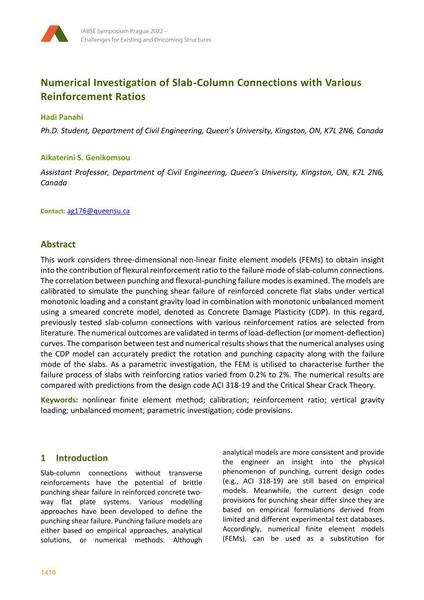Numerical Investigation of Slab-Column Connections with Various Reinforcement Ratios

|
|
|||||||||||
Détails bibliographiques
| Auteur(s): |
Ambadas Waghmare
(Ph.D. Student, Department of Civil Engineering, Queen’s University, Kingston, ON, K7L 2N6, Canada)
Ananth Ramaswamy (Assistant Professor, Department of Civil Engineering, Queen’s University, Kingston, ON, K7L 2N6, Canada) |
||||
|---|---|---|---|---|---|
| Médium: | papier de conférence | ||||
| Langue(s): | anglais | ||||
| Conférence: | IABSE Symposium: Challenges for Existing and Oncoming Structures, Prague, Czech Republic, 25-27 May 2022 | ||||
| Publié dans: | IABSE Symposium Prague 2022 | ||||
|
|||||
| Page(s): | 1410-1418 | ||||
| Nombre total de pages (du PDF): | 9 | ||||
| DOI: | 10.2749/prague.2022.1410 | ||||
| Abstrait: |
This work considers three-dimensional non-linear finite element models (FEMs) to obtain insight into the contribution of flexural reinforcement ratio to the failure mode of slab-column connections. The correlation between punching and flexural-punching failure modes is examined. The models are calibrated to simulate the punching shear failure of reinforced concrete flat slabs under vertical monotonic loading and a constant gravity load in combination with monotonic unbalanced moment using a smeared concrete model, denoted as Concrete Damage Plasticity (CDP). In this regard, previously tested slab-column connections with various reinforcement ratios are selected from literature. The numerical outcomes are validated in terms of load-deflection (or moment-deflection) curves. The comparison between test and numerical results shows that the numerical analyses using the CDP model can accurately predict the rotation and punching capacity along with the failure mode of the slabs. As a parametric investigation, the FEM is utilised to characterise further the failure process of slabs with reinforcing ratios varied from 0.2% to 2%. The numerical results are compared with predictions from the design code ACI 318-19 and the Critical Shear Crack Theory. |
||||
| Copyright: | © 2022 International Association for Bridge and Structural Engineering (IABSE) | ||||
| License: | Cette oeuvre ne peut être utilisée sans la permission de l'auteur ou détenteur des droits. |
||||
